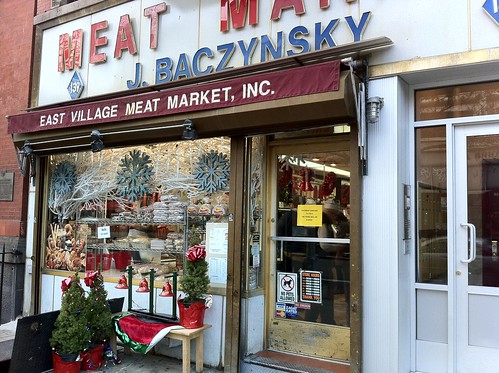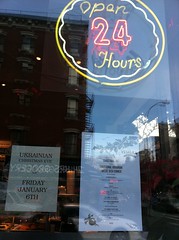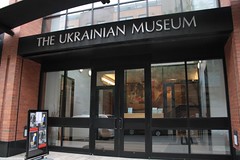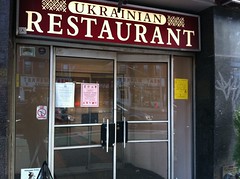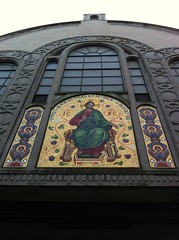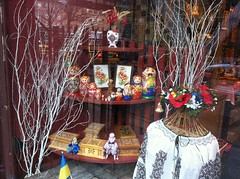At the East Village Meat Market on Second Avenue, tiny firs, pots of poinsettias and ringing bells greet customers gearing up to celebrate the birth of Christ on Jan. 7 (which corresponds with Dec. 25 in the Julian calendar) – evidence that in the neighborhood once known as Little Ukraine, Christmas is coming.
Andrew Ilnicki, the store’s 50-year-old manager, spoke as customers shopped for smoked meats, breads, borscht mixes, pierogi, and jellied pigs’ feet. “On Christmas Eve,” he said, meaning Jan. 6, “people serve non-meat food, which can be dairy; a lot of fish; and kutya, which is a pearled wheat with poppy seeds.”
“You can make kutya richer with honey and walnuts and raisins,” he said, describing one of 12 dishes that make up a traditional Ukrainian Christmas Eve supper. “On Christmas, there will be hams. They’re very popular with people. We cure them, smoke them, bake them and sell them.”
As Mr. Ilnicki spoke, the store’s owner, Julian Baczynsky, looked on with a paternalistic smile. Mr. Baczynsky was a displaced person in a German labor camp before he migrated to New York in 1949, one of tens of thousands of Slavic immigrants to do so after World War II.
“I worked for a farmer in Germany,” he recalled, adding that he has a degree from a German college and has learned to speak seven languages. He described himself with a grin as “just a young fellow – 88 and a half years old.”
Mr. Baczynsky opened his now iconic market in 1970, after closing a store he ran on Avenue B in 1955. It has since drawn visits from a multitude of locals and dignitaries ranging from the first President of Ukraine to Ray Kelly, the city’s police commissioner.
Wolodymyk Darmochwol, late founder of Veselka, also worked in a German labor camp in his youth. He “died with his boots on” in 1975, said his son-in-law, Tom Birchard, who took over the business at that time.
Mr. Birchard, who is not Ukrainian, said he learned about Eastern European immigrant culture through his former wife Marta. “I married the boss’s daughter and she taught me all about the traditions including the Christmas traditions,” he said over the telephone. He noted that Veselka, which opened in 1954, began offering a 12-course Christmas Eve special several years ago. It includes an early course of borscht with dumplings.
“Each course has a little bit of symbolism to it,” Mr. Birchard said, adding that the restaurant’s Christmas Eve special is also offered at Veselka’s new Bowery outpost.
Veselka and the Ukrainian East Village Restaurant, on the same block, are one of the few that have survived higher rents and continuing gentrification in the East Village. The neighborhood was once a beacon for Ukrainian immigrants who fled both Nazi occupation and later Soviet rule in the 20th century, bringing with them their culture, tradition and religious beliefs. But many of the descendents of those immigrants have moved to other locations in New York.
“Once the younger people grew up, they tended to go the suburbs,” said Maria Shust, director of the Ukrainian Museum on East Sixth Street. “They had jobs and families. Some of the younger people are coming back if they can afford it here. There was a large influx of immigration to the East Village after the breakup of the Soviet Union, but it’s too expensive here so they tended to go to Brooklyn and Queens.”
Ms. Shust, who was born in Germany, is the daughter of Catholic Western Ukrainian immigrants who, she said, fled their country with other groups “before the Communists took over.” Ms. Shust said that Ukrainians who worked in the displaced person camps after World War II established their own communities. “They formed schools and youth groups and theaters and when they came here they brought what was most precious to them and they wanted to preserve them.”
The Ukrainian Museum’s Christmas exhibit, on the first floor, includes an eight-foot-tall tree (due to fire codes, it’s fake) bedecked with hand-made folk ornaments, and a traditional Christmas puppet show. The museum is open Wednesday through Sunday but will close early on Saturday and all of Sunday during the holiday.
At St. George Ukrainian Catholic Church, a domed Byzantine-style edifice on East Seventh Street that is run by Greek Catholic monks belonging to the Order of St. Basil the Great, there will be a Christmas Eve mass Friday evening at 9 p.m., and a solemn liturgical mass at 10 p.m. Rev. Bernard Panczuk, the pastor of the church, said the 10 p.m. mass is similar to the Christmas Eve midnight mass in the Gregorian calendar. He noted there will be two Christmas Day masses on Jan. 7 at 10 a.m. and noon. Most of the masses at the church, which celebrated its centennial in 2005, are in the Ukrainian tongue.
“New York City has so many immigrants and because there’s a constant flow from the Ukraine of documented and undocumented people, many like to keep ties with the Ukraine,” said Father Panczuk. But he said the situation in America can get confusing: some parishioners celebrate Christmas twice, since so many colleagues and students observe the holiday on Dec. 25.
Surma, a colorful Ukrainian shop and general store across the street from St. George, will close at 4 p.m. on Jan. 6 in observance of Christmas Eve, said the proprietor Markian Surmach, 49, whose late immigrant grandfather founded the store in 1918 – one year after the Bolshevick revolution in Russia elicited a wave of immigration. He said holiday shoppers like to buy things like nesting dolls and Christmas tree ornaments with Ukrainian patterns. Bags of kutya mixed with honey, raisins and walnuts which can be purchased for $2.50 a pound.
The store also sells jars of honey, candies, Ukrainian newspapers, religious icons and peasant blouses purchased by the likes of Joan Baez, Janis Joplin and members of the Jefferson Airplane during the 1960s, said Mr. Surmach.
He acknowledged he was not a member of St. George’s congregation. “I go my own way,” he said.
This post has been revised to reflect the following correction:
Correction: January 6, 2011
The original version of this post misspelled the surname of the manager at East Village Meat Market and mistakenly referred to Ukraine as the Ukraine. The country is commonly referred to as “the Ukraine” (as in Father Panczuk’s direct quote), but this is incorrect.
Correction: January 11, 2011
The original version of this post incorrectly stated that Ukrainians celebrate Christmas on Jan. 7 in the Julian calendar. In fact, it is Dec. 25 on that calendar, which corresponds with Jan. 7 on the Gregorian calendar.



